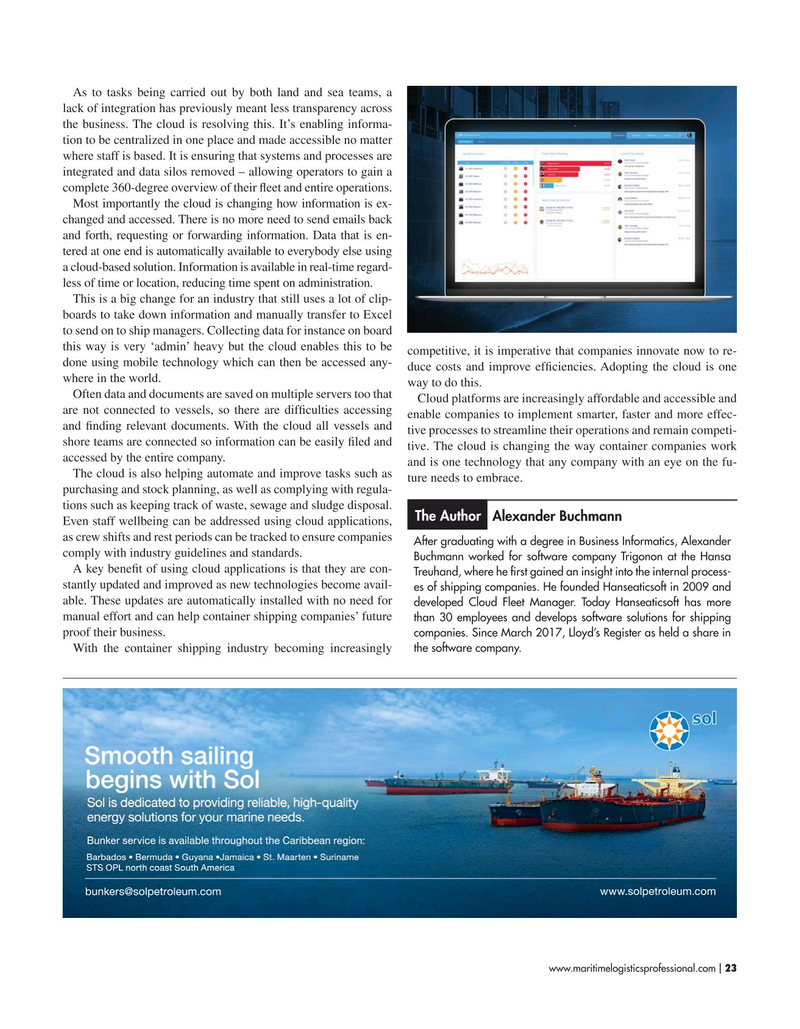
Page 23: of Maritime Logistics Professional Magazine (Mar/Apr 2019)
Container Ports
Read this page in Pdf, Flash or Html5 edition of Mar/Apr 2019 Maritime Logistics Professional Magazine
As to tasks being carried out by both land and sea teams, a lack of integration has previously meant less transparency across the business. The cloud is resolving this. It’s enabling informa- tion to be centralized in one place and made accessible no matter where staff is based. It is ensuring that systems and processes are integrated and data silos removed – allowing operators to gain a complete 360-degree overview of their ?eet and entire operations.
Most importantly the cloud is changing how information is ex- changed and accessed. There is no more need to send emails back and forth, requesting or forwarding information. Data that is en- tered at one end is automatically available to everybody else using a cloud-based solution. Information is available in real-time regard- less of time or location, reducing time spent on administration.
This is a big change for an industry that still uses a lot of clip- boards to take down information and manually transfer to Excel to send on to ship managers. Collecting data for instance on board this way is very ‘admin’ heavy but the cloud enables this to be competitive, it is imperative that companies innovate now to re- done using mobile technology which can then be accessed any- duce costs and improve ef?ciencies. Adopting the cloud is one where in the world.
way to do this.
Often data and documents are saved on multiple servers too that
Cloud platforms are increasingly affordable and accessible and are not connected to vessels, so there are dif?culties accessing enable companies to implement smarter, faster and more effec- and ?nding relevant documents. With the cloud all vessels and tive processes to streamline their operations and remain competi- shore teams are connected so information can be easily ?led and tive. The cloud is changing the way container companies work accessed by the entire company.
and is one technology that any company with an eye on the fu-
The cloud is also helping automate and improve tasks such as ture needs to embrace. purchasing and stock planning, as well as complying with regula- tions such as keeping track of waste, sewage and sludge disposal.
The Author Alexander Buchmann
Even staff wellbeing can be addressed using cloud applications, as crew shifts and rest periods can be tracked to ensure companies
After graduating with a degree in Business Informatics, Alexander comply with industry guidelines and standards.
Buchmann worked for software company Trigonon at the Hansa
A key bene?t of using cloud applications is that they are con-
Treuhand, where he ?rst gained an insight into the internal process- stantly updated and improved as new technologies become avail- es of shipping companies. He founded Hanseaticsoft in 2009 and able. These updates are automatically installed with no need for developed Cloud Fleet Manager. Today Hanseaticsoft has more manual effort and can help container shipping companies’ future than 30 employees and develops software solutions for shipping proof their business. companies. Since March 2017, Lloyd’s Register as held a share in the software company.
With the container shipping industry becoming increasingly www.maritimelogisticsprofessional.com 23
I

 22
22

 24
24
